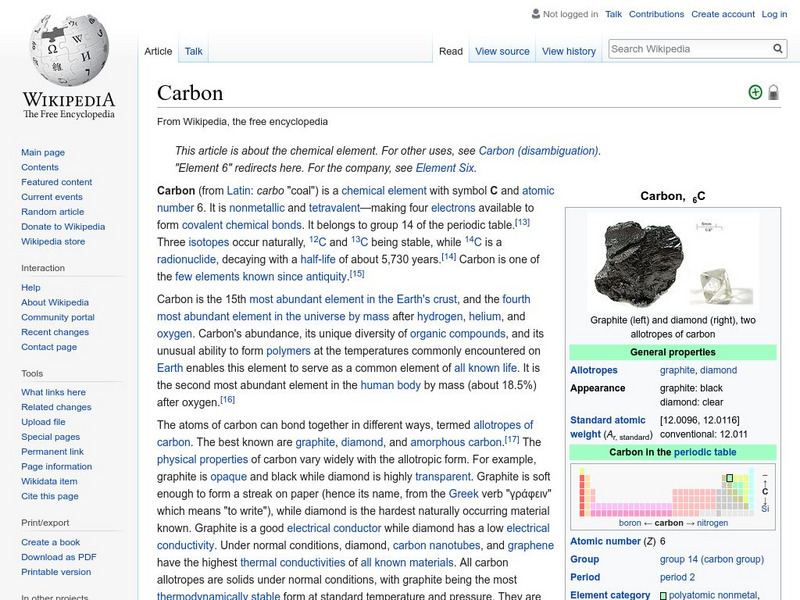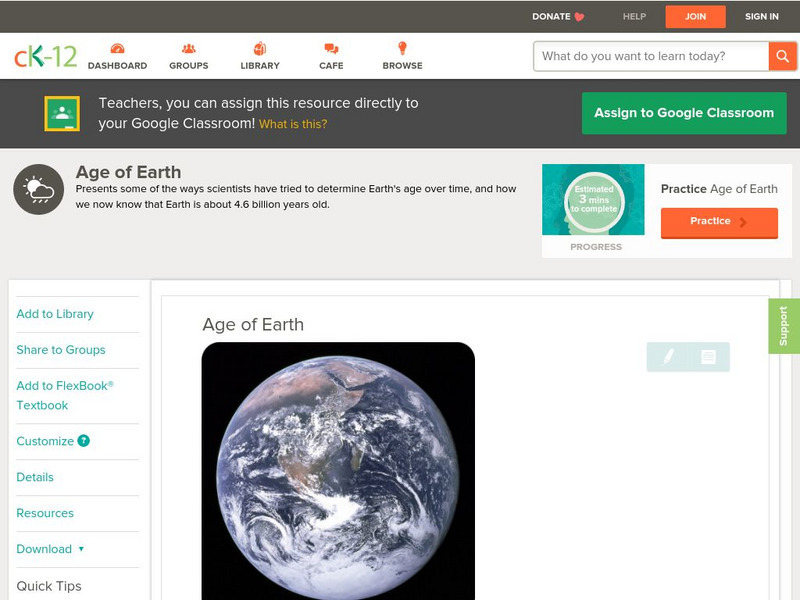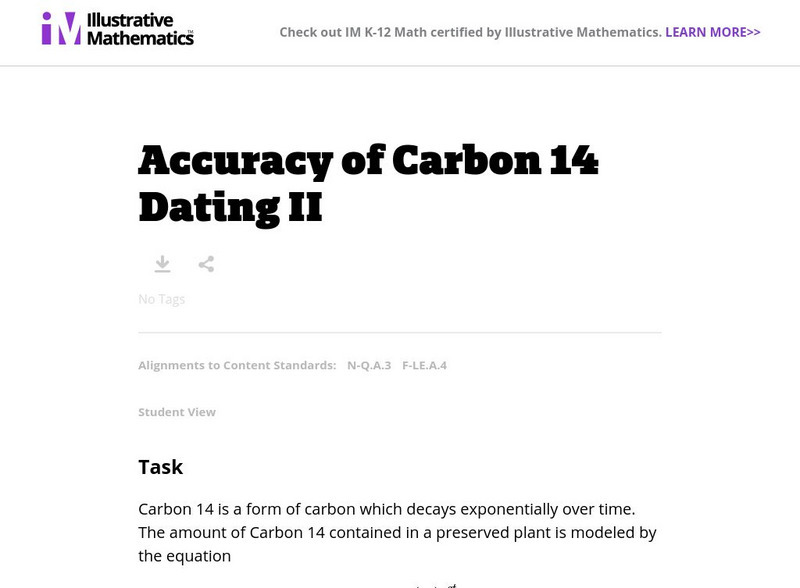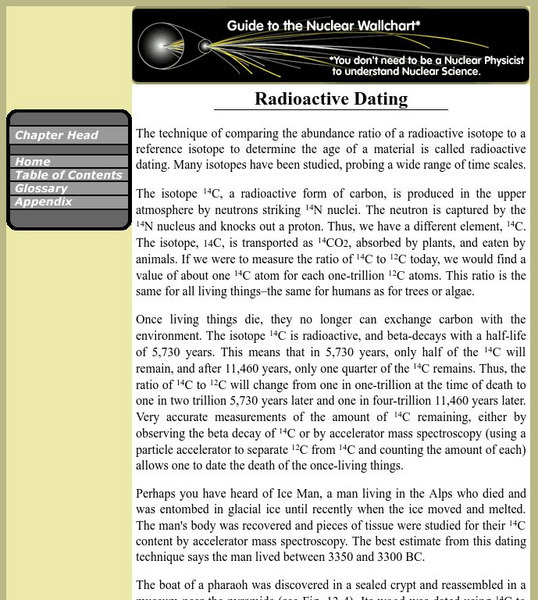Pace University
Grades 9-12 Earth Science
How has Earth changed over time? Pupils explore the topic in a differentiated instruction unit on the geological time scale. After a pre-assessment to gauge knowledge, class members divide into groups based on their ability levels and...
Utah Education Network (UEN)
Utah Open Textbook: Chemistry
Technology can help save money and add convenience. The resource offers a free textbook for a complete Chemistry course. The text begins with a review of the scientific method and continues to explain topics such as chemical bonding,...
Columbus City Schools
The Mystery of Earth’s History
Every living creature can leave a fossil record, yet most fossils belong to extinct organisms rather than ones currently living. Scholars learn about dating rock layers, fossils, and the environment of the past. Pupils understand that...
Virginia Department of Education
Determining Absolute Age
How can radioactive decay help date old objects? Learners explore half-life and radioactive decay by conducting an experiment using pennies to represent atoms. Young scientists graph data from the experiment to identify radioactive decay...
Curated OER
WS 6.7 Effects & Applications of Nuclear Chemistry
In this nuclear chemistry worksheet, learners are given the biological effects of nuclear radiation. They are also given a list of uses of nuclear chemistry and Einstein's theory of special relativity to calculate the energy change in...
Curated OER
Determining the Age of Fossils
Students explore radioactive dating using a radiometric Dating website. In this chemistry lesson plan, students will work in small groups to collect data that shows how fossils are dated. As a follow-up, students will research a...
Curated OER
Determining the Age of Fossils
Students examine the concept of radioactive dating. In this radioactive dating instructional activity, students investigate how to determine the ages of fossils and rocks as they learn about half-life radioactive decay.
Curated OER
Effects and Applications of Nuclear Chemistry
For this nuclear chemistry worksheet, students determine the biological effects and the applications of nuclear chemistry. Then students use Einstein's theory of special relativity to complete 3 problems.
Story Behind the Science
Story Behind the Science: Just How Old Is Earth? [Pdf]
Article describing efforts in the 19th and 20th centuries to determine the Earth's age, particularly using naturally occurring radioactivity. It notes that scientific disciplines frequently overlap in the work they do. Questions are...
Other
Nrc: Unit 2 the Uses of Radiation
A lesson plan on the uses of radiation in science, industry, and medicine. Gives many household examples of how radiation is used. Students will also learn about the NRC's role in regulating radioactive materials.
CK-12 Foundation
Ck 12: Half Life
[Free Registration/Login may be required to access all resource tools.] In this module, students will explore the radioactive decay process in terms of balanced nuclear equations to discover the concept of half-life.
Australian Museum
Australian Museum: Radioactive Dating
This article explains what radioactive dating is and describes the different techniques used, what they are used for, and the limitations of each.
Science Education Resource Center at Carleton College
Serc: Radioactive Dating: Looking at Half Lives Using M&ms
In this activity, students gain a better understanding of radioactive dating and half-lives by using M&Ms to demonstrate the idea of radioactive decay. They will be able to see how scientists can determine the age of rocks by looking...
Wikimedia
Wikipedia: Carbon
This article from Wikipedia contains great information on the element carbon. Links are provided throughout the article to provided additional information. The topics include: Notable Characteristics, Applications, History, Allotropes,...
CK-12 Foundation
Ck 12: Radioactive Half Life
[Free Registration/Login may be required to access all resource tools.] Explains radioactive half-life and radioactive dating, and demonstrates how to solve problems with each.
CK-12 Foundation
Ck 12: Earth Science: Age of Earth
[Free Registration/Login may be required to access all resource tools.] How scientists have been able to determine the age of Earth.
CK-12 Foundation
Ck 12: Physical Science: Half Life and Radioactive Dating
[Free Registration/Login may be required to access all resource tools.] Explains radioactive dating, how it works, and how carbon-14 is used to date the remains of living things.
Illustrative Mathematics
Illustrative Mathematics: N q.a.3 and F le.a.4: Accuracy of Carbon 14 Dating Ii
This task is a refinement of "Carbon 14 dating" which focuses on accuracy. Aligns with N-Q.A.3 and F-LE.A.4.
CK-12 Foundation
Ck 12: Physics Simulation: Radiocarbon Dating
[Free Registration/Login Required] Learn about how radiocarbon dating works and how anthropologists can use this method to figure out who long ago people lived. A PDF worksheet and a video tutorial are also available. [5:41]
CK-12 Foundation
Ck 12: Physics Simulation: Marie Curie's Classroom
[Free Registration/Login Required] Study the basics of radioactive decay and the properties of atomic nuclei in Marie Curie's laboratory and classroom. A PDF worksheet and a video tutorial are also available. [3:32]
Australian Museum
Australian Museum: Dating the Earth
How do scientists know how old the Earth is? What is radioactive dating? Are there other dating methods? Get the answers to these questions and others at this site presented by the Australian Museum Online.
Lawrence Berkeley National Laboratory
Berkeley Lab: Radioactive Dating
This site provides an overview of radioactive dating, a process used to determine the age of rocks and other materials.
Other
How to Date a Fossil
Radiometric dating, fission-track dating, and amino-acid dating are explained in this succinct site.








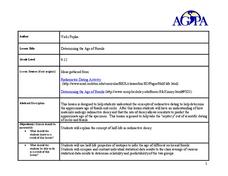

![Story Behind the Science: Just How Old Is Earth? [Pdf] Article Story Behind the Science: Just How Old Is Earth? [Pdf] Article](https://d15y2dacu3jp90.cloudfront.net/images/attachment_defaults/resource/large/FPO-knovation.png)




